Odisha State Board CHSE Odisha Class 11 Biology Solutions Chapter 13 Photosynthesis in Higher Plants Textbook Questions and Answers.
CHSE Odisha 11th Class Biology Chapter 13 Question Answer Photosynthesis in Higher Plants
Photosynthesis in Higher Plants Class 11 Questions and Answers CHSE Odisha
Very Short Answer Type Questions
Multiple Choices Questions
Question 1.
Oxygenic photosynthesis does not occurs in
(a) plants
(b) green sulphur bacteria
(c) bryophytes
(d) cyanobacteria
Answer:
(b) green sulphur bacteria
Question 2.
Cyclic electron transfer around PS-I results in the formation of
(a) ATP
(b) NADPH
(c) ATP and NADPH
(d) ATP, NADPH and O2
Answer:
(a) ATP
Question 3.
In higher plant chloroplasts, the chlorophylls are located in
(a) stroma
(b) lumen of grana
(c) outer membrane
(d) thylakoid membrane
Answer:
(d) thylakoid membrane
Question 4.
All algae generally have
(a) chlorophyll-a and chlorophyll-b
(b) chlorophyll-a and ß-carotene
(c) chlorophyll-b and ß-carotene
(d) phycoerythrin and ß-carotene
Answer:
(a) chlorophyll-a and chlorophyll-b
Question 5.
In C4 -plants, the first stable product of CO2-fixation in mesophyll cells is
(a) 3-phosphoglycerate
(b) dihydroxyacetonephosphate
(c) oxaloacetate
(d) phosphoenol pyruvate
Answer:
(c) oxaloacetate
Question 6.
During light absorption and emission by chlorophyll molecule, the length of fluroscent light is
(a) longer than that of absorbed light
(b) shorter than that of absorbed light
(c) equal to that absorbed light
(d) equal to that of phosphorescent light
Answer:
(a) longer than that of absorbed light
Question 7.
Electron donor to PS-I is
(a) cyt-b
(b) cyt-b6
(c) ferredoxin
(d) plastocyanin
Answer:
(d) plastocyanin
Question 8.
The reaction centre of PS-II is:
(a) P600
(b) P680
(c) P700
(d) P750
Answer:
(b) P680
Question 9.
The ions essential for photolysis of water during photosynthesis are
(a) Mn++, Ca++ and Cl–
(b) Mg++, Ca++ and Cl–
(c) Cu++, Ca++ and Mg++
(d) Fe++, Ca++ and Mn++
Answer:
(a) Mn++, Ca++ and Cl–
Question 10.
The fist reaction of photosynthesis is
(a) excitation of chlorophyll
(b) photolysis of water
(c) ATP formation
(d) CO2-fixation
Answer:
(a) excitation of chlorophyll
Fill in the blanks
Question 1.
The graph showing the effectiveness of different wave lengths of light on the photosynthetic activity of leaves is known as …………… .
Answer:
Action spectrum
Question 2.
In higher plants the reaction centre chlorophyll of PS-I is …………. .
Answer:
P700
Question 3.
In C4-plants Rubisco is present is the chloroplasts of ………….. cells.
Answer:
Spongy
Question 4.
The accepter of CO2 during photosynthesis in bundle sheath cells of C4-plants is …………….. .
Answer:
RuBP. (Ribulose-1, 5 biphosphate)
Question 5.
Kranz type of leaf anatomy is seen in ………….. plants.
Answer:
C4
Short Answer Type Questions
Question 1.
Absorption spectrum
It is the curve that shows the amount of different wavelength of lights absorbed by a substance (photosynthetic pigment). The graph given below shows the ability of chlorophyll-a to absorb lights of different wavelengths.
Chlorophyll-a shows the maximum absorption peak at 450 nm and also shows another peak at 650 nm.
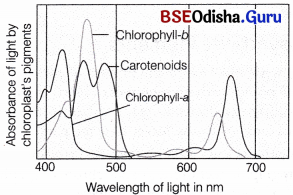
Graph showing the absorption spectrum, of chlorophyll-a, b, and the carotenoids
Question 2.
Photosystem
Answer:
During the course of light reaction, light is absorbed by photosynthetic pigments present in the quantasomes of grana thylakoids.
These photosynthetic pigments are organised into two discrete photochemical Light Harvesting Complexes (LHCs) known as Photosystem-I (PS-I) and Photosystem-II (PS-II).
The light harvesting complexes or photosystems are made up of hundreds of pigment molecules bounded by proteins. Each photosystem has a photocentre or reaction centre, where actual reaction takes place.
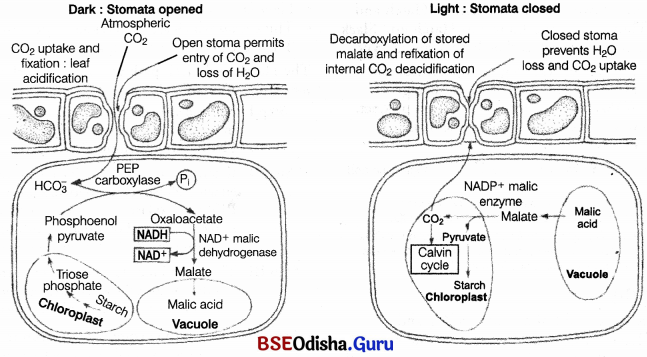
Question 3.
Photolysis of water
Answer:
The electrons are continuously supplied to the photosystems-II by the available electrons, which get replaced due to the splitting of water.
In this process, the water splits into protons, electrons and oxygen. The complex for water splitting is associated with the photosystems-II that is located on the inner side of the thylakoid membrane. Mn+ and Cl- ions also play important role in the photolysis of water molecule. These electrons thus, obtained by the splitting of water are needed to replace those electrons which are removed from the photosytems-I thus, are provided by photosystem-II.
2H2O → 4H+ + O2 ↑ + 4e–
While all the electrons formed, are replaced, the protons get accumulated in the lumen of the thylakoid and the oxygen is evolved into the atmosphere.
Question 4.
Photophosphorylation
Answer:
Phosphorylation is the process through which, ATP is synthesised from ADP and inorganic phosphate (P) by the cell organelles (like mitochondria and chloroplasts). When it occurs in the presence of sunlight in chloroplast, it is called photophosphorylation.
Phosphorylation in mitochondria is not light dependent, but it uses the energy by oxidation of nutrients to produce ATP, hence it is called oxidative phosphorylation.
Question 5.
Photorespiration
Answer:
It is a light dependent cyclic process of oxygenation of RuBP and release of carbon dioxide by the photosynthetic organs of a plant. The site of photorespiration is chloroplast. Mitochondria and peroxisome are also required for completing the process. RuBP carboxylase, oxygenase is the main enzyme of dark reaction. It also catalyses another reactions that interferes with the functioning of Calvin cycle. It has active site for both, i.e. CO2 and O2.
The relative concentration of CO2 and O2 determines which of the two will bind to the enzyme.
Under the conditions, when O2 concentration is more in atmosphere than CO2, C3-plants, RuBisCO acts as oxygenase enzyme and CO2-fixation does not lead to PGA formation. Instead phosphoglycerate and phosphoglycolate are formed and photorespiration occurs.
Question 6.
CAM plants
Answer:
Some plants belonging to family-Crassulaceae have special kind of adaptation for performing photosynthesis. These are succulent photosynthetic xerophytic plants. These plants keep their stomata open during night and fix CO2 in the night and use it in the day time. This is a xerophytic adaptation of plants to reduce transpiration rate by keeping stomata shut during day time. The events of this process are summarised in the flow chart given below

Long Answer Type Questions
Question 1.
Describe the light reaction of photosynthesis.
Answer:
5 Light Reaction (The Photochemical Phase)
Light reaction includes the following steps, i.e. absorption of light, splitting of water, release of oxygen and finally the formation of high energy chemical intermediates, i.e. ATP and NADPH.
Light Absorption
During the course of light reaction, light is absorbed by photosynthetic pigments present in the quantasomes of grana thylakoids.
These photosynthetic pigments are organised into two discrete photochemical Light Harvesting Complexes (LHCs) known as Photosystem-I (PS-I) and Photosystem-II (PS-II).
The light harvesting complexes or photosystems are made up of hundreds of pigment molecules bounded by proteins. Each photosystem has a photocentre or reaction centre, where actual reaction takes place.
This reaction centre contains a special chlorophyll-a molecule. It is fed by hundred other pigment molecules and it forms the light harvesting system called antennae. These antennae molecule absorb light of different wavelength, but shorter than reaction centre in order to make photosynthesis more efficient.
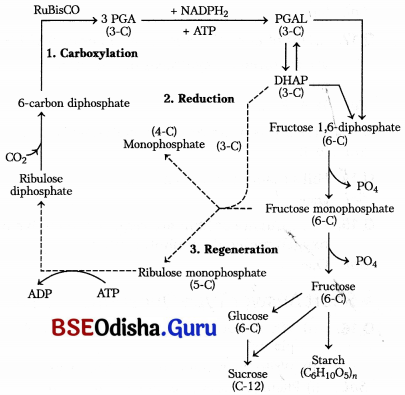
The light harvasting complex
The reaction centre is different in both the photosystem as given below
(i) In PS-I, the reaction centre or chlorophyll-a has peak of absorption at 700 nm, known as P700.
(ii) In PS-II, the reaction centre has absorption peak at 680 nm hence, called P680.
Question 2.
Explain different phases of Calvin cycle.
Answer:
The C3 Cycle
This is a cyclic biochemical pathway of reduction of CO2 or photosynthetic carbon, which was discovered by Calvin.
The Calvin cycle runs in all photosynthetic plants, no matter they show C3, C4 or any other pathway. It occurs in stroma of the chloroplast.
Primary Acceptor of CO2 in C3 Pathway
After a long research and conducting many experiments it was concluded by the scientists that in C3 pathway, the acceptor molecule is a 5-carbon ketose sugar, i.e. Ribulose 5-Bisphosphate (5 RuBP). Calvin or C3 cycle has many steps which are known as glycotic reversal or formation of sugar and takes place between reduction and regeneration. There are three major steps as follows
1. Carboxylation
It is the most crucial step of the Calvin cycle. In this fixation of CO2 molecule takes place in the form of carboxylation of RuBP(5C). This reaction is catalysed by the enzyme RuBP carboxyase. This finally leads to the formation of two molecules of 3 Phosphoglyceric Acid (3PGA). As the RuBP carboxylase enzyme also has an activity of oxygenation. Thus, it is more commonly known as RuBP carboxylase-oxygenase or RuBisCO.
Img 5
Diagrammatic representation of Calvin cycle, regeneration of RuBP is indicated by broken lines
2. Reduction
After the carboxylation reaction, reduction of PGA takes place through a series of reactions leading to the formation of glucose.
In this step, the ATP (as energy source) and NADPH (hydrogen atom carrier) are utilised.
It is to be noted that 2 molecules of ATP and 2 molecules of NADPH are utilised in this step for phosphorylation and for the reduction of CO2, respectively.
Hence, the fixation of 6 molecules of CO2 and 6 turns of the cycle are required in order to release one molecule of glucose from the pathway.
3. Regeneration
For the continuous and uninterrupted functioning of the Calvin cycle, there must be a regular supply of ATP, NADPH and also sufficient amount of RuBP is required. The regeneration of RuBP (CO2 acceptor) is a complex process and involves many types of sugar starting from triose (3C) to heptose (7C).
The regeneration step requires one ATP molecule for phosphorylation. Hence, for every CO2 molecule that enters the Calvin cycle are required 3 molecules of ATP and 2 molecules of NADPH.
Thus, in order to produce one molecule of glucose through the Calvin pathway, 18 ATPs and 12 NADPHs are required.
Question 3.
Explain different phases of C4 pathway.
Answer:
The C4 Pathway
It was worked out by two Australian scientists Hatch and Slack (1966). Thus, this is also known as Hatch and Slack pathway. C4-plants are special as they have a special type of leaf anatomy that can tolerate high temperatures and show a response to high intensities. Inspite of having Oxaloacetic Acid (OAA) as their first CO2 -fixation product, they use C3 pathway or the Calvin cycle as the main photosynthetic pathway.
Note:
- Only angiospermic (no gymnosperm, bryophytes and pteridophytes, etc.) plants show this process to fix CO2.
- The main aim of C4-cycle is to fix very dilute solution of CO2 (0.03% or 300 ppm) to concentrated CO2 solution in bundle sheath cells to produce Oxaloacetic Acid (OAA).
Kranz Anatomy:
According to the structural leaf anatomy of C3 and C4-plants, the leaves of C3-plants show only one type of cells called mesophyll cells, which contain only mesophyll chloroplast, while leaves of C4-plants show two types of cells, i.e., outer mesophyll cells and inner spongy (which are large) cells around the vascular bundles called bundle sheath cells arranged in a circular manner.
It refers to the presence of two types of the chloroplast, in the leaves. The mesophyll cells contain well-developed granal chloroplast. They actively participate in light reaction. These produce ATP and NADPH2.
The rudimentary chloroplasts are present in the cells of bundle sheath. They are agranal. The bundle sheath cells are mainly meant to carryout C3 cycle.
This does not require well-developed chloroplast, so they are rudimentary lamellar type.
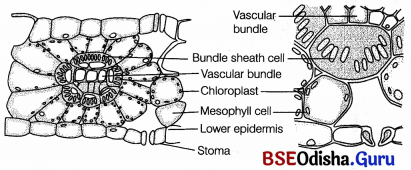
TS of maize leaf showing Kranz anatomy
The bundle sheath cells tend to form several layers around the vascular bundles.
They possess several special features such as
- Have large number of chloroplast.
- Thick walls which are impervious to gaseous exchange.
- There are no intercellular spaces.
The Hatch and Slack pathway is also a cyclic process, which occurs in following steps
Step I: In C4-plants, the initial fixation of CO2 occurs in mesophyll cells. The primary acceptor of CO2 is Phosphoenol Pyruvate (PEP).
Step II: It combines with CO2 in the presence of an enzyme phosphoenol pyruvate carboxyfcise or PEP carboxylase (PEPcase) to form the first stable (or a 4 carbon organic acid) product of C4 pathway, i.e. the Oxaloacetic Acid (OAA).
Step III: The compound (OAA) are transported to the bundle sheath cells where they are broken down, releasing CO2 and a 3-carbon molecule.
Step IV: The 3-carbon compound is again transported back to the mesophyll cells where regeneration of PEP takes place, thus, completing the cycle.
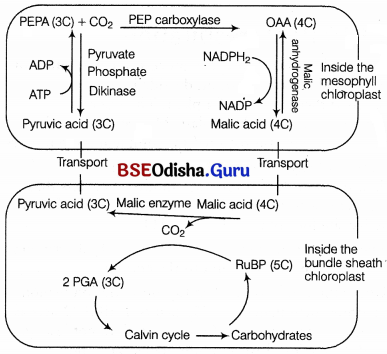
Schematic representation of Hatch and Slack pathway
The CO2 thus, released in the bundle sheath cells enters the C3 or the Calvin cycle (common pathway to all plants).
